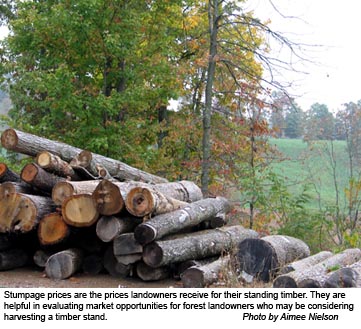Timber Market Remains Soft, UK Ag Economist Says
Timber Market Remains Soft, UK Ag Economist Says

The timber market in Kentucky has been “somewhat soft” this year, in large part due to a sharp drop in stumpage prices for red oak and a continued decline in prices for white oak, said Greg Halich, an agricultural economist at the University of Kentucky College of Agriculture. Red and white oak are the state’s two most important commercial timber species.
“Here in Kentucky, red and white oaks make up roughly half of the total harvested sawtimber volume,” Halich said. “Those are the two main markets that are down right now.”
Stumpage prices are the prices landowners receive for their standing timber. They are helpful in evaluating market opportunities for forest landowners who may be considering harvesting a timber stand.
Prices for white oak have been in decline for about 10 years and are not expected to reverse anytime soon, Halich said. The drop in stumpage prices for red oak, however, is a recent phenomenon, with prices decreasing nearly 25 percent in the past two years. Consequently, he advises forest landowners to hold off harvesting medium and high-quality stands of red oak.
“A nice benefit of timber ownership is that timber can be held for long periods of time without harvesting,” Halich said. “Prices will hopefully rebound in the next five years for the red oak species, and so it probably makes sense to wait to harvest these stands. White oak stumpage prices, however, have been down for nearly a decade. Waiting to harvest higher quality white oak stands would be much more risky.”
On the other hand, lower quality red and white oak stands might be good candidates for harvest. Markets for pallet lumber and railroad ties, where much of the lower grade oak is sent, have remained strong, Halich said.
“Stumpage prices for lower quality oak stands have not dropped as sharply compared to higher quality oak stands,” he said.
In contrast to the declining stumpage prices for oak, prices for hard maple and black cherry have been rising. But these species make up a much smaller percentage of the harvested timber volume in Kentucky – 6 percent for hard maple, about 1 percent for black cherry – and have less impact on the Kentucky timber industry. Nevertheless, landowners with mature stands of these species may want to take advantage of the higher prices, he said.
“Stumpage increases for black cherry have been phenomenal in the past 10 years and can easily be three to four times that of oak. Now is a good time to consider harvesting these stands,” Halich added.
Stumpage prices for yellow poplar, hickory and walnut have remained relatively stable in recent years and “there is no reason to either cut stands quickly or wait in the hope that prices will increase,” he said. Hickory is normally associated with oak stands and is typically harvested when the more significant oak component of a stand is cut.
Recommendations for ash are more difficult to make, Halich said, because stumpage prices for this species dropped sharply in the 1980s and then leveled off. Compounding the price drop is the potential infestation of the emerald ash borer, a pest that has devastated ash stands in southern Michigan and northern Ohio.
“Unless a biological control can be found, the borer will eventually move into Kentucky,” Halich said. “Forest landowners whose stands have a heavy ash component face a dilemma: waiting in hope of rising stumpage prices but with the possibility that their stands may eventually become worthless. Salvage cuts just ahead of the borer’s path have the potential to flood already weak ash markets.”
Doug McLaren, forestry specialist with the UK Cooperative Extension Service, said that landowners should consult a professional forester to determine when to harvest their trees, as well as which trees to cut. A forester considers what is best for the landowner in terms of prices and market, but he also takes into account the needs of the forest stand and forest health.
The timber industry is one of Kentucky’s most important industries, with 11.6 million of the state’s 12 million acres of forest classified as timberland. About 78 percent of Kentucky’s timberland is owned by private individuals who annually sell about $153 million worth of standing timber .
